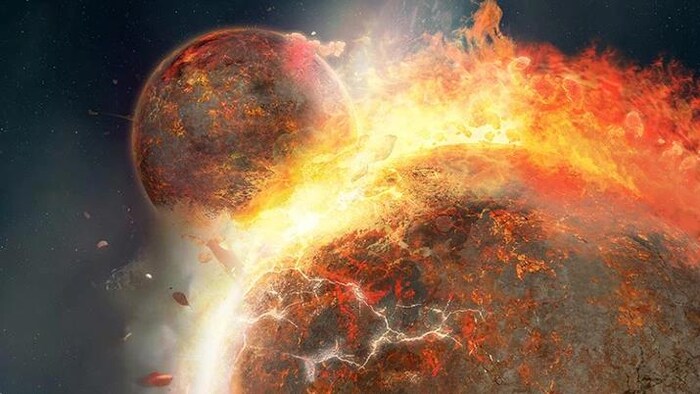Open in full screen mode The protoplanet Theia violently collided with the proto-Earth, leading to the creation of the Moon. (Artistic illustration) Agence France-Presse Feature being tested Log inCreate my account Speech synthesis, based on artificial intelligence, makes it possible to generate spoken text from written text. Scientists propose a new theory capable of solving two mysteries in one go, one revolving every day around the Earth and the other concerning the bowels of our planet. The first enigma is the origin of the Moon, for which the most commonly accepted theory is its appearance after the impact of a forming planet with the future Earth, 4.5 billion years ago years. The collision with Theia, a protoplanet the size of Mars, would have propelled a sufficient amount of material into the Earth's surface. space for its agglomeration to form the Moon. It remained to find remains of Théia. By looking not in the air, but underground, according to the study published in Nature (New window) (in English) by a team of scientists from mainly American institutions. Because 2900 km below the surface, two large superplumes have intrigued scientists since their discovery using seismic waves in the 1980s. Laid deep in the Earth's mantle, the layer separating the Earth's core from its crust, these masses, each the size of a continent, are located under Africa and the Pacific Ocean. They are warmer and denser than the environment that surrounds them. And the researchers' computer simulations suggest that these masses are buried relics of Theia, which entered Earth at the time of the collision. This collision was the most violent event suffered by the Earth in its history, Qian Yuan, a geodynamics researcher at California Institute of Technology (CalTech) and first author of the study. Which makes it very, very strange that there is no visible trace left, according to him. And what motivated his thinking: Where is the impactor? My answer: underground. The research led experts from two very distinct specialties, space and geology, to collaborate. Théia hit the Earth, then in formation, at more than 36,000 km/h, a speed sufficient for part of the #x27;impactor penetrates very deep into the Earth's lower mantle. These pieces of essentially molten rock, tens of kilometers wide, cooled and, solidifying, descended to the limit of the Earth's mantle and core. Helped in this by a greater proportion of iron oxide than that of the terrestrial environment, which made them heavier. They accumulated into two distinct masses, each of which is larger than the Moon, according to Mr. Yuan, who also insists that these conclusions remain the result of necessarily imperfect models and simulations. An expert in Earth science and planetary exploration at the University of Stirling, Scotland, told AFP that the theory put forward by Mr. Yuan fits with several existing clues. This is a significant finding, according to Christian Schroeder, who did not participate in the study. Even if it does not, according to him, resolve the question of the origin of the Moon, this theory provides a credible explanation for the anomalies observed at the boundary between the mantle and the core. As for the remains of Theia, they may well be responsible for important ongoing processes on Earth. The masses are believed to convey plumes from the mantle, rises of magma, towards the surface of the earth's crust. A phenomenon linked to volcanic eruptions, but also to the evolution of supercontinents. For Mr. Yuan, the impact of Théia played a role in the evolution of the Earth over 4.5 billion years. And this is what he believes would make it unique […] different from other rocky planets.
Earth may be home to pieces of another planet

